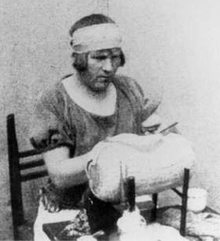Pioneers of Gender Reassignment Surgery
By Siobhan Donegan
Having written various articles on transgender individuals, I thought it would be a good idea to look in slightly more detail at the surgical procedures that were very experimental at the time of the early 1900s.

It was Dora Richter in 1931 (Berlin) who was the first known trans woman to undergo gender realignment surgery – as such she made of course history. She was born in Germany in 1891 in the Erzbirge region to a poor family. From an early age, Dora experienced what is now described in medical terminology as ‘gender dysphoria’. Dora apparently always felt deeply uncomfortable wearing male attire. Dora’s parents were incredibly open minded allowing her at the time to live as female. However, Dora’s inner feminine identity was too strong to be satisfied with this and at the age of only six using a tourniquet, attempted to remove her penis, which one online writer described as a ‘DIY version’ of the operation she would eventually have.
Dora, also known as Dochan ‘little Dora’ was lucky enough to come under the supervision and care of the German Physician Magnus Hirsch who was and is famous for being the founder of the scientific discipline of Sexology. He has been described as ‘an early sexual rights activist and founder of the institute of sexual research’. It was at this institute that Dora was given the freedom to live as a woman. This in fact was during the era of the extraordinary liberal Weimar Republic, at the time being the ‘Gay Capital’ (Berlin) sometimes referred to as the LGBT capital of Europe.
Despite this, it was still very difficult for trans women to find suitable employment. However, the Institute of Sexual Research also helped in this capacity including providing employment for a number of trans women including Dora, who worked at the Institute as a housekeeper for more than ten years.

The Institute of Sexology attracted a number of Doctors into its field of research. One such Doctor being Dr Ludwig Levy Lenz, who will be mentioned further on. It was under the supervision of Dr Erwin Gohrbandt at the Charite Univeritatmedizin that Dora underwent a surgical procedure known as an orchiectomy, which in general terminology is castration. Furthermore, the impact of the reduced levels of testosterone on Dora’s general anatomy was studied for the purpose of research. One of the Doctors involved with this was Dr Felix Abraham who made the following observations about the outcome of this specific surgery that included restricted beard growth, the first visible signs of breast development and a more ‘feminine shape’ being seen in the pelvic fat pad.
However, it wasn’t until a further nine years had passed that Dora was able to have her penis surgically removed and ultimately undergo genital reconstructive surgery. This operation which was carried out by two Doctors, including Levy Lenz, was a complete success. Unfortunately, the liberal Weimar Republic came to an end with the rise of the Nazi power. As such despite the fact that Dora stayed in Berlin, her fate has remained unknown.

Dora’s operation may have been experimental and even dangerous, but was nevertheless successful, and inevitably created a significant amount of publicity. It was this that ultimately attracted Lili Elbe to the Institute. It was in Berlin that Lili Elbe underwent the first of her surgeries under Dr Erwin Gohrbandt, and under the supervision of Dr Magnus Hirschfield. This initial operation involved the removal of the testicles. Her subsequent following surgeries were performed by Doctor Kurt Warnekros, at the Dresden Municipal Women’s Clinic.
Lili Elbe, her full name being Lili Ilse Elvenes, actually underwent a series of four surgical procedures over a period of two years. Her first operation, being only a few weeks after Dora Richter’s operation. The first procedure was to remove the patient’s testicles, whilst retaining the scrotum sack. The second operation carried out by Dr Warnekros was to in fact transplant an ‘ovary into her abdominal musculature’, furthermore to remove the penis and remaining scrotum. The fourth procedure, in 1931, was to actually transplant a uterus and to finally surgically ‘construct’ a vaginal canal. Unfortunately, Lili Elbe tragically died just three months after this ambitious surgery as her immune system ultimately ‘rejected’ the transplanted uterus. Furthermore, an attempt at a ‘surgical revision’ had the unfortunate consequence of causing an infection, which resulted in Lili’s tragic death of cardiac arrest on 13 September 1931.

The first trans man to undergo sex reassignment surgery was again a German individual, Karl. M. Baer who also won the right to serve in the German military (the first trans man in the West). In America, and perhaps slightly more well-known than K. Baer, was Alan. L. Hart, who was a tuberculosis specialist by profession. Hart drew inspiration from the Baer case and sought out Joshua Allen Gilbert Ph.d M.D. Hart presented Gilbert with the argument that he had ‘abnormal inversion’ and as such should be sterilized, in other words he was ultimately seeking surgery to ‘eliminate menstruation’. Gilbert was reluctant at first but accepted the fact that Hart only experienced themselves as a man. Hart was ultimately successful as he finally underwent medical treatment known as hysterectomy and gonadectomy.

Hart drew inspiration from the Baer case and sought out Joshua Allen Gilbert Ph.d M.D. Hart presented Gilbert with the argument that he had ‘abnormal inversion’ and as such should be sterilized, in other words he was ultimately seeking surgery to ‘eliminate menstruation’. Gilbert was reluctant at first but accepted the fact that Hart only experienced themselves as a man. Hart was ultimately successful as he finally underwent medical treatment known as hysterectomy and gonadectomy. Some historians note that Hart never described himself as transgender, but the term was not published until the 1920s, and not widely used until the 1960s, near Hart’s death. It is also true, that Hart worked hard to keep his transition a secret from others, and would hardly have sought to publicly claim a trans identity. Others have argued that Hart was a trans pioneer who lived after his transition exclusively as a man, just as modern transgender people do.

